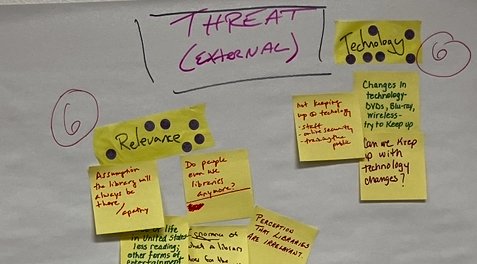Weekly Posts and Insights

Pre-Season Strategic Planning: Discover Before You Decide With Surveys
Surveys and assessments are essential tools for gathering meaningful feedback that informs strategic planning, decision-making, and organizational improvement. This blog explores how to design effective surveys, avoid common pitfalls like survey fatigue, and build trust by using and communicating results. Learn the types of surveys to consider—and why feedback is a gift that should shape, not just support, your leadership.

Pre-Season Strategic Planning: Discover Before You Decide with SWOT Analysis
Kick off your strategic planning season with two essential tools: SWOT analysis and surveys. This blog explores how to facilitate meaningful SWOT sessions, engage stakeholders across sectors, and use dot voting to identify top priorities. Start with data-driven discovery to guide future decisions and build trust throughout your organization or community.

Leading the Disgruntled: How to Cultivate Renewal in Your Senior Team
In our Greenthumb Leadership framework, Stage 3 is called Disgruntled. These are your seasoned professionals. They’re knowledgeable. They’ve been in the system long enough to know how it works—and sometimes, how to work around it. But they’re tired. Jaded. Resistant. These are the overgrown plants in your garden. Once full of potential, they’ve picked up weeds, disease and bugs along the way: resentment, cynicism, and detachment. The real problem with Disgruntled C-suiters? They often hold the most power, most influence and most control. And, in that respect, they can be the most dangerous.

Accountability: Discipline vs. Empathy
This post explores the delicate balance between accountability and empathy in leadership, especially in a time when staff are feeling burned out and undervalued. Drawing from Crucial Accountability and thought leader Dr. Jay Campbell, it outlines how leaders can hold people to high standards while still showing compassion. The key is moving beyond avoidance or aggression to have respectful, clear, and constructive conversations that build trust and drive results. True leadership lives in the tension between expectation and empathy—and that’s where real transformation begins.

Becoming a Yardstick of Excellence: Accountability, Quality, and the Mindset for Excellence
In this post we explore how accountability drives organizational excellence and culture, inspired by Steve Jobs' iconic quote: “Be a yardstick of quality.” Drawing from the book Crucial Accountability and real-life leadership moments, he outlines how mindset, clarity, and consistent conversations shape high-performing teams. Learn why culture is built in the everyday "moments of truth," as leadership expert Jan Carlzon emphasized, and how to raise the bar without losing your team’s trust. Perfect for executives, team leaders, and HR professionals focused on improving accountability, trust, and performance.

The Power of Silence (and Writing)
In a world of nonstop noise, true leadership sometimes requires silence. This post explores how journaling and intentional reflection—anchored in the practices of Resonant Leadership—can deepen self-awareness, build resilience, and support authentic leadership growth. Drawing from real retreat experiences and the research of James Pennebaker and Brené Brown, it offers practical tips for starting a journaling habit that heals and empowers.

Building Resilience Through Practice, Habits, and Daily Discipline
Practice alone isn’t enough; making practice a habit is where real transformation happens. True grit—the ability to persevere through adversity—and real resilience depends on small, repeated acts. Over time, these acts build into powerful capabilities.

Strategic Vision Soufflé
A soufflé perfectly captures the essence of a leader’s vision—it starts with a strong foundation, requires delicate preparation, and rises with care and precision to create something breathtaking. Like a great vision, it inspires, stretches boundaries, and demonstrates that with the right balance of ingredients, a remarkable outcome is achievable.

One Year Later
Over the past year, we’ve explored the shift from workplace culture to community, delving into themes like belonging, trust, adaptability, and leadership as service. Through concepts like the Upside-Down Community Leader, Greenthumb Leadership, and the Deep Ocean Model, we’ve examined how leaders can foster growth, navigate change, and address underlying beliefs. This journey has highlighted that leadership is intentional and requires continuous learning, with the hope of inspiring growth and meaningful connections in others.

A Leadership Recipe for the Holidays
Good food is all about timing, intention, and a willingness to experiment. Leadership is no different. So, this holiday, let’s take a detour from boring leadership jargon and straight into the heart of the kitchen—a place where raw ingredients transform into something magic. Great leadership, like great food, can feed the soul. Here are the essential ingredients for the perfect leadership dish.